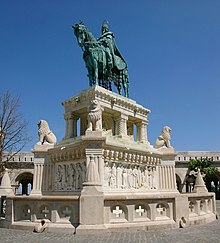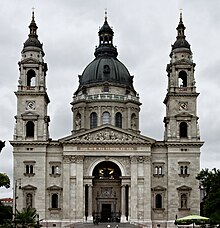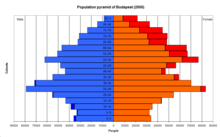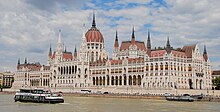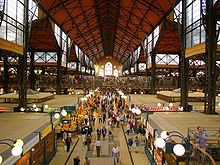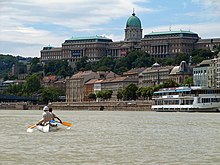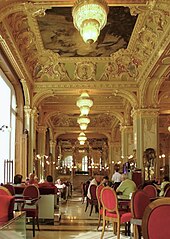Budapest
| Budapest | ||||
|
||||
| Basic data | ||||
|---|---|---|---|---|
| State : | Hungary | |||
| Region : | Central Hungary | |||
| County : | Budapest | |||
| Coordinates : | 47 ° 30 ' N , 19 ° 3' E | |||
| Height : | 102 m | |||
| Area : | 525.13 km² | |||
| Residents : | 1,752,286 (January 1, 2019) | |||
| Population density : | 3,337 inhabitants per km² | |||
| Telephone code : | (+36) national 06 1 | |||
| Postal code : | 1011-1239 | |||
| Structure and administration (status: 2018) | ||||
| Community type : | city | |||
| Structure : | 23 boroughs | |||
| Mayor : | Gergely Karácsony ( PM ) | |||
| Website : | ||||

Budapest ( Hungarian pronunciation [ 'budɒpɛʃt ]; ) is the capital and largest city of Hungary . With over 1.7 million inhabitants, Budapest is the ninth largest city in the European Union . According to the British market research company Euromonitor International , it is one of the twenty most visited cities in Europe by tourists. The unified municipality of Budapest was created in 1873 by amalgamating the previously independent cities of Buda ( Eng. Oven ), Óbuda ( old oven ), both west of the Danube , and Pest, east of the Danube. The name Budapest itself did not show up earlier, common in the language was Pest-Buda .
geography
location
Budapest lies on the Danube , which at this point leaves the Hungarian low mountain range and flows into the Hungarian lowlands . The highest point in Budapest is the 527-meter-high János Mountain (János-hegy in Hungarian), part of the Buda Mountains . Other Buda Mountains are the Gellért Hill (Gellért-hegy), the Castle Hill (Várhegy), the Rose Hill (Rózsadomb), the Sun Mountain (Naphegy), the Eagle Mountain (Sashegy), the Martinsberg (Mártonhegy), the Swabian Mountain (Svábhegy) and the Széchenyiberg (Széchenyi-hegy). From a geotectonic point of view, the city lies on a fracture point , which is why Buda is particularly rich in thermal springs .
climate
Because of its inland location and the shielding effect of the mountains, Budapest has a relatively dry continental climate with cold winters and warm summers. The mean temperatures are -1.6 ° C in January and 21 ° C in July. The most abundant rainfall is recorded in early summer. The average amount of precipitation a year is around 500 to 600 millimeters.
| Budapest | ||||||||||||||||||||||||||||||||||||||||||||||||
|---|---|---|---|---|---|---|---|---|---|---|---|---|---|---|---|---|---|---|---|---|---|---|---|---|---|---|---|---|---|---|---|---|---|---|---|---|---|---|---|---|---|---|---|---|---|---|---|---|
| Climate diagram | ||||||||||||||||||||||||||||||||||||||||||||||||
| ||||||||||||||||||||||||||||||||||||||||||||||||
|
Average monthly temperatures and rainfall for Budapest
Source: WMO 1961–1990
|
|||||||||||||||||||||||||||||||||||||||||||||||||||||||||||||||||||||||||||||||||||||||||||||||||||||||||
history
First millennium
Roman times
Budapest's history begins around 89 with the establishment of a Roman military camp in an area formerly inhabited by the Celtic tribe of the Eraviski . As a result, the Roman settlement Aquincum , which was the capital of the province of Pannonia Inferior between 106 and 296 , developed around the camp . The city prospered under Roman rule, there is evidence of a governor's palace, several amphitheaters and baths, and the city, located on the endangered Roman Danube border, was walled.
Great Migration
At the end of the 4th century, during the migration of peoples, there were more incursions of Germanic and Hunnic - Alanic tribes; After the fall of the Roman Empire and the end of the Great Migration, a Slavic population initially settled here, but from 896 they were displaced by Hungarians , Uralic peoples who immigrated to the Pannonian lowlands .
middle Ages
Early Middle Ages
The Hungarians, who later became Christianized and settled, lived in villages with churches and farmed and raised cattle. In the center of important traffic routes, Pest became more and more important. Already at this time there was a brisk ferry traffic across the Danube (e.g. at today's Elisabeth Bridge ) to the opposite Buda. With the coronation of Stephen I (on Christmas Day 1000 or January 1, 1001) as the first king of Hungary , the Hungarians expanded their supremacy. The Mongol invasion (“ Mongol Storm ”) in 1241 resulted in almost complete destruction after the battle of Muhi . The royal residence was initially moved to Visegrád . In 1308 the city was renewed and in 1361 the capital of the kingdom. In 1514 a peasant uprising took place.
Turkish occupation
From 1446 the Ottomans repeatedly attacked Hungary, which culminated in the occupation of most of the country. Pest fell in 1526 and Buda, which was somewhat protected by the castle, 15 years later. The capital of the unoccupied Hungary, which almost entirely of Upper Hungary (essentially what is now Slovakia was), was from 1536 to 1784 Pressburg (Bratislava) . While Buda became the seat of a Turkish pasha, Pest received little attention and lost a large part of its population.
Habsburg era
Finally, the Habsburgs , who had been kings of Hungary since 1526, succeeded in driving out the Ottomans and restoring Hungary (see also: Siege of Ofen (1684/1686) ). However, little changed for the population of Buda and Pest; it was still administered by strangers and had to pay very high taxes. The residents fought back in an uprising that was suppressed.
Modern times
Seat of the king
Pest had been the seat of the kingdom's administrative administration since 1723. Despite the adverse conditions and a devastating flood in 1838, with 70,000 victims, it became one of the fastest growing cities of the 18th and 19th centuries. In 1780 German was introduced as the official language by the Habsburgs. This was also done in order to better control the revolutionary movements that flared up again and again. This also did justice to the German settlers who were regularly called into the country and who now settled large parts of the city. The heartland of the Croatians , for example the area of today's Croatia, was subordinate to Budapest.
Bridge building
One of the main reasons for the boom in Budapest was the existence of a bridge in summer, which consisted of boats attached to each other. The Chain Bridge (Hungarian Széchenyi Lánchíd) spans the Danube here in Budapest. It was built between 1839 and 1849 as the first permanent bridge at the suggestion of the Hungarian reformer Count István Széchenyi . He was encouraged to do this after waiting a week to come to the other bank for his father's funeral. It bears the Hungarian name in his honor. It is the oldest and most famous of the nine Budapest bridges over the Danube.
Revolution 1848/49
During the Hungarian Revolution of 1848, Budapest was one of the main centers of the unrest with which the Hungarians fought against the anti-reform oppression of the Habsburgs. It is true that the uprising was ultimately bloodily suppressed with the help of Russia , but the events of 1849 indirectly led to the settlement between Austria and Hungary in 1867 . This made Hungary largely independent. Emperor Franz Joseph's annual stay of several weeks in Budapest was a symbol of compensation . As King of Hungary he resided at Buda Castle and during this time - dressed in the Hungarian language and in a Hungarian uniform - he held his Hungarian offices with the Hungarian ministers and the Royal Hungarian Diet .
Merger of Buda / Pest
The amalgamation of Buda, Óbuda and Pest had already been decreed in 1849 under the revolutionary government of Hungary. When the Habsburgs restored their power, they revoked this decision. It was not until 1873, six years after the Austro-Hungarian Compromise of 1867, that the two halves of the city were finally united. This was preceded as early as 1870 by the establishment of a “ capital city council for public works ”, which was supposed to coordinate the structural and infrastructural development of the entire city.

20th century
Early 20th century
To mark the millennium of the Hungarians' “conquest” (the so-called Millennium) in 1896, numerous major projects were completed in connection with the Budapest Millennium Exhibition in 1896 , such as Heldenplatz and the first subway on mainland Europe. The population in the entire urban area increased sevenfold between 1840 and 1900 and rose to around 730,000.
First World War and the aftermath
After losing the First World War and the resulting fatalities, Hungary left the Danube Monarchy in 1918 . With the Treaty of Trianon , Hungary lost almost three quarters of its territory.
The communist Hungarian Soviet Republic under Béla Kun , founded in March 1919, lasted only four months. It collapsed when Romanian troops occupied Budapest and large parts of Hungary in the Hungarian-Romanian War in early August, whereupon members of the council government fled to Vienna. The socialist Gyula Peidl was Prime Minister for a short time, but his government was ousted on August 6, 1919 in an armed coup by right-wing forces. The successor state was the Kingdom of Hungary under Miklós Horthy . After his victory, Horthy moved into Budapest at the head of the conservative troops on November 16, 1919 and became the dictatorial imperial administrator (regent; Hungarian: "kormányzó") of Hungary, which was still formally a kingdom.
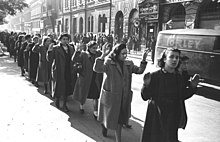
Second World War
The German occupation of Hungary during the Second World War ( Operation Margarethe ) began on March 19, 1944 and came after Hungary tried to break away from allied Germany. Around a third of the Hungarian Jewish population, numbering six hundred thousand, was killed by the end of the war. Most of them were deported to Auschwitz by the Nazis from 1944 onwards . However, the deployment of several diplomats, including the Swede Raoul Wallenberg and the Swiss Carl Lutz , saved the lives of numerous Budapest Jews and saved them from deportation. In the same year parts of Budapest were destroyed by American and British air raids. The greatest devastation occurred when Soviet forces besieged the city from late December 1944 to early February 1945 during the Battle of Budapest until it was captured . The trapped German and Hungarian troops blew up all bridges over the Danube on their retreat to the Buda side of the basin. 38,000 civilians died during this phase of the war.
post war period
After the war, the Republic of Hungary was proclaimed in 1946 and the People's Republic of Hungary in 1949 . A short episode was the youth project Gaudiopolis from 1945 to 1951 . In 1956 Budapest was the starting point of the popular uprising directed against the Soviet Union . After its bloody suppression, waves of purges broke out across the country.
Turning point since 1989
The Republic of Hungary was proclaimed in Budapest on October 23, 1989. Among other things, this paved the way for the collapse of the Soviet Union and the entire Eastern Bloc . In 2000, celebrations took place across Hungary to mark the millennium of the founding of the state. The capital was also beautified on this occasion. The park and the Millenáris Park cultural center as well as the Millennium City District with the National Theater were built. The Buda Danube side with the Technical University campus has been modernized. The EU accession of Hungary was with many festivals throughout the country, especially in the capital Budapest, celebrated on 1 May 2004.
In August 2011, at the instigation of Mayor István Tarlós , the city assembly decided to introduce a new city flag. The previous one had been in use since the unification of Buda, Pest and Óbuda in 1873 and showed their colors: red, yellow and blue. These are coincidentally, albeit in a different order, also the colors of Romania, which was felt to be offensive in view of the not exactly easy relationship with the neighboring country.
population
Population development
In the following, the population numbers are listed according to the respective territorial status. Until 1860 these are mostly estimates, until 2001 census results and 2006 an estimate by the Hungarian Central Statistical Office. The numbers before 1873 refer to the three cities of Buda, Pest and Óbuda. Their final merger took place on November 17, 1873, after the first merger on June 24, 1849 was reversed a short time later.
The sharp increase in population between 1949 and 1960 is due to the incorporation of seven cities and 16 municipalities in the area. On January 1, 1950, the population rose by 582,000 to 1.64 million, the area from 206 square kilometers to 525 square kilometers, and the number of city districts from 14 to 22.
|
|
|
|
|
- Source since 2012:
- Source for 2011:
- Source for 2001-2009:
- Source for 1949-2000:
- Source for 1720–1947:
Development of the ethnic composition
In the 15th century, the majority of the population of Pest was Hungarian. After the end of the Ottoman rule over Hungary, Buda in particular was dominated by Germans.
- pest
- 1715: around 2,500 inhabitants, 55.6% of them Germans , 19.4% Magyars (Hungarians), 2.2% Slovaks , 22.8% others
- 1737: Population n / a, of which 57.8% Germans, 22.5% Hungarians, 5.6% Slovaks, 14.1% others
- 1750: 62,471 inhabitants, 55.2% Germans, 22.2% Hungarians, 6.5% Slovaks, 16.1% others
- Buda + Pest + Óbuda, i.e. Budapest
- 1851: 178,062 inhabitants, of which 56.4% Germans, 36.6% Magyars, 5% Slovaks, 2% others
- 1881: 370,767 inhabitants, of which 55.1% Magyars, 33.3% Germans, 6% Slovaks, 2.8% others
- 1891: 506,384 inhabitants, of which 326,533 (67.1%) Magyars, 115,573 (23.7%) Germans, 27,126 (5.6%) Slovaks, 5.6% others
- 2001: 1,777,921 inhabitants, of which 1,631,043 (91.2%) Magyars, 18,097 (1%) Germans, 14,019 (0.8%) Roma , 4,929 (0.3%) Slovaks ..., 93,071 (5th , 2%) no information
Religions
Overview
The following overview shows the percentage of believers of different denominations in the total population between 1870 and 1949.
table
| Religion all figures in percent |
1870 | 1880 | 1890 | 1900 | 1910 | 1920 | 1930 | 1941 | 1949 |
|---|---|---|---|---|---|---|---|---|---|
| roman catholic | 72.3 | 67.4 | 64.7 | 60.7 | 59.8 | 59.1 | 60.7 | 63.7 | 71.3 |
| reformed | 4.8 | 6.1 | 7.4 | 8.9 | 9.9 | 10.9 | 12.1 | 13.6 | 15.5 |
| Lutheran | 5.3 | 5.5 | 5.6 | 5.3 | 5 | 4.8 | 5 | 5.3 | 5.4 |
| Jewish | 16.6 | 19.7 | 21st | 23.6 | 23.1 | 23.2 | 20.3 | 15.8 | 6.4 |
| other | 1 | 1.3 | 1.3 | 1.5 | 2.2 | 2 | 1.9 | 1.6 | 1.4 |
administration
Districts
The city consists of three formerly independent cities that were only united to form the municipality of Budapest in 1873. On the eastern, flat side of the Danube lies Pest, which takes up two thirds of the city area, on the western, mountainous side Buda (dt. Furnace ) and Óbuda (dt. Old furnace ) the remaining third of the city.
Districts
Budapest is administratively divided into 23 districts. On January 1, 1950, the city was divided into 22 districts, the 23rd (XXIII.) Was later spun off from the 20th (XX.). Starting from the first district around the castle district (Vár), the districts are numbered clockwise with Roman numerals, whereby the Danube is skipped several times. Districts in green are in Pest, districts in red are in Buda, and those in yellow are on the island of Csepel .
Town twinning
Budapest has partnerships with the following cities:
| city | country | since |
|---|---|---|
| Ankara |
|
2015 |
| Berlin |
|
1992 |
| Comrat |
|
2005 |
| Florence |
|
2008 |
| Fort Worth |
|
1990 |
| Frankfurt am Main |
|
1990 |
| Lisbon |
|
1992 |
| new York |
|
1991 |
| Beijing |
|
2012 |
| Chongqing |
|
2010 |
| Sarajevo |
|
1995 |
| Shanghai |
|
2013 |
| Odorheiu |
|
2016 |
| Tehran |
|
2015 |
| Tel Aviv-Jaffa |
|
1989 |
| Warsaw |
|
2005 |
| Vienna |
|
1990 |
| Zagreb |
|
1994 |
Sights and culture
Buildings, streets and statues
Many of the city's noteworthy buildings stand on the banks of the Danube . On the western, Buda side, the rocky Gellért Hill rises with the Statue of Liberty and the Citadel . At the foot of the mountain is the Hotel Gellért with its famous thermal baths and, further down the river, the main building of the Technical and Economic University . To the north of Gellért Hill is the castle hill with the former royal castle, the castle palace . The palace houses the National Library , the National Gallery and the Historical Museum . The Hungarian President has his seat next to the castle in the classical Palais Sándor . At the foot of the castle hill is the Várkert Bazar, which ends the castle complex facing the Danube.
In the northern part of the castle hill there is the Matthias Church and, in front of it, the Fisherman's Bastion . The Buda Castle District and the Danube panorama have been on the UNESCO World Heritage List since 1987 . A partly publicly accessible labyrinth system runs under the castle district.
On the eastern bank of the Danube, on the flat Pest side, the Parliament Building , the Academy of Sciences , a number of large hotels on the so-called Danube Parade, the Pesti Vigadó Concert Hall , the Corvinus University of Economics in Budapest and, further south, the National Theater and the Art Palace.
The Danube is the actual main attraction of Budapest and is spanned by nine bridges that shape the cityscape . The most important, because it is the oldest and at the same time the city's landmark, is the Chain Bridge .
From here, on the Pest side, the small ring leads to the Liberty Bridge , past the Great Synagogue , the National Museum and the Great Market Hall . The synagogue in Dohány utca marks the entrance to the historic Jewish quarter of Budapest, located between the Small and Large Ring. The Small Ring roughly follows the course of the earlier Pest city wall, the last city gates of which were demolished at the end of the 18th century. Remnants of the city wall are still standing. Budapest's actual city center is located between the Little Ring and the Danube. Váci utca, the oldest trade route and now the most famous promenade in the city, runs parallel to the river . It connects the Great Market Hall with Vörösmarty tér . To the north of the city center, but still in the central 5th district, rises the tallest church building in Budapest, the St. Stephen's Basilica .
The Great Ring (Nagykörút) was built between 1872 and 1906. It leads from the Petőfi Bridge to the Margaret Bridge and is one of the most important architectural ensembles of its time in Europe. The west station (Nyugati pályaudvar) located here, together with the east station (Keleti pályaudvar), is a testimony to the splendid station architecture.
On the Great Ring, the sections of which bear the names of St. Stephen and the neighboring districts of Teréz, Erzsébet, József and Ferencváros, there are several theaters (until it was blown up in 1965, there was also the National Theater here, on Blaha-Lujza-Platz) and many movie theaters, some of which had to close in the late 1990s because the multiplex cinemas at Westbahnhof and other parts of the city were able to attract more viewers. At the octagonal square Oktogon, the ring is crossed by Andrássy út , which connects the city center with the city park .
Andrássy út is one of the most outstanding urban development projects in the Hungarian capital. In just 14 years, from 1871 to 1885, a 2.4-kilometer-long avenue was built, which is lined with lavishly furnished, six-storey historicist apartment buildings , the Hungarian State Opera , the House of Terror and several squares. It leads to Heldenplatz , which in turn is bordered by the Kunsthalle and the Museum of Fine Arts. The Millennium Monument, which was erected in 1896 to mark the anniversary of the Hungarian conquest , stands on this square . South of the Heldenplatz is the elongated square of the 56-er , on which the memorial of the uprising of 1956 stands. A wedge made of steel steles of different heights, apparently coming from the city forest, pushes itself under the pavement of the square exactly at the point where a statue of Stalin was overthrown in 1956 and the May Day marches took place for decades . Fifty years after the 1956 uprising, the memorial was unveiled on October 23, 2006 at 7:56 p.m.
Andrássy út has also been a World Heritage Site since 2002 . The first Budapest subway runs under it , it is one of the first electric subways in the world and, after the London Underground, one of the oldest in the world.
Farther east out of town, directly behind Heroes' Square, in the city park are Vajdahunyad Castle , which was built for the Budapest Millennium Exhibition in 1896 , the zoo , the circus, the figure skating rink and the Széchenyi spa . Together with the Gellért bath, it is one of the most famous of the Budapest thermal baths .
The Gül Baba Türbe is located on the Rose Hill in Buda, Mecset út 14 ( Lage ). It has an octagonal shape and was built around 1545. It is the northernmost sanctuary in Islam . Gül Baba (* late 15th century in Merzifon, Amasya province; † September 1, 1541) was a Turkish Bektashi dervish and poet of the 16th century.
Outside the city center, on the western bank of the Danube, you can see the Roman settlement Aquincum. More recently there is the sculpture park with statues from the period of socialist realism .
On the east bank is the Shoes on the Danube Bank memorial , which commemorates the pogroms against Jews in World War II.
Theater and concert building

The most important theater is the Hungarian National Theater Nemzeti Színház , or “Nemzeti” for short , which has been located in Bajor Gizi Park since 2002. The well-known stage in the country often had to change its seat. From 1837 to 1908 the first, simple building stood in what was then Kerepesi út, today Rákóczi út, opposite the Hotel Astoria. The original name was Pesti Magyar Színház (Pest Hungarian Theater). Since 1840 the theater has been called Nemzeti Színház.
The Magyar Színház (Hungarian Theater) is located at Hevesi-Sándor-Tér. The performances of the Katona József Theater in Petőfi Sándor-utca (the Hungarian stage director Tamás Ascher often works here) and the Új Theater (New Theater) are intended for a young audience. An alternative stage for unusual theater projects is the Krétakör Theater by the Hungarian director Árpád Schilling .
Friends of musicals and operettas like to visit the Operettszínház on "Hungarian Broadway" in Nagymező utca. A traditional stage is the Vígszínház ( Comedy Theater ) on körút on the Pest side. Opera fans appreciate the more traditionally staged performances of the Hungarian State Opera Magyar Állami Operaház , whose house in Andrássy-út has many similarities to the Vienna State Opera.
For children, the performances of the Bábszínház Puppet Theater , also in Andrássy-út, are interesting. The most famous concert hall is the Art Nouveau festival hall of the Music Academy on Liszt-Ferenc-Platz. The modern Bartók Béla concert hall, which is located near the National Theater, meets the most modern acoustic requirements. Concerts are also held in the rooms of the Budapest Congress Center.
Museums
Museums in Budapest (the names of the museums are displayed with the mouse pointer) |
The largest art collection, the Museum of Fine Arts in Budapest , is located on Heroes' Square. It includes an ancient collection, a gallery of old masters, an Egyptian collection, a collection from the 19th – 20th centuries. Century, a baroque sculpture collection, a collection of German, Austrian, Dutch and Flemish paintings. In addition to the permanent exhibitions, temporary exhibitions of international importance are held regularly, such as the exhibition on Vincent van Gogh's works at the end of 2006, which attracted a huge number of visitors. The museum has been closed since April 15, 2015 due to a complete renovation. It will reopen on October 31, 2018.
Opposite the museum is the Budapest Art Gallery for modern art projects. The Hungarian painting is exhibited in the National Gallery in the Castle Palace. The Budapest Ludwig Museum has been located in the Palace of the Arts near the new National Theater since 2005 .
The Art Nouveau building of the Hungarian Museum of Applied Arts is located on Üllői út, and the Ethnographic Museum is located on Kossuth Square . The Holocaust Documentation Center has been located in the Páva Synagogue and the subsequent new building by István Mányi since 2004 .
In addition to more than 30 museums, the cultural center of Hungary has many small galleries , most of which can be found in the city center or in the castle district.
Cultural events
Every year, two major cultural festivals take place in Budapest, in the framework of which programs for lovers of classical music are offered: the Budapest Spring Festival and the Budapest Autumn Festival. For film fans there is the Hungarian Film Show in February and the Titanic International Film Festival in April, as well as an international theater festival. In August the island festival "Sziget" takes place with many concerts for mainly young visitors.
A new cultural center on the Buda side is Millenáris Park, which was built in 2000 on the occasion of the millennium celebrations for the foundation of the state on an old factory site. Concerts, exhibitions and other cultural events take place here in summer. The children's playground has hand-carved figures taken from a folk tale. Since October 2005, the Hungarian Children's Museum Palace of Miracles has also had a new home here.
Other leisure activities

The mountainous surroundings of Budapest offer many excursion possibilities such as the picturesque small town of Szentendre north of Budapest and the castle in Gödöllő , the favorite place of Queen and Empress Sisi . The Danube Bend extends to Esztergom . The Lakihegy transmission mast rises south of the city on the Csepel Island near Halásztelek .
The children's train runs in the Buda Mountains, the highest point of which is Jánosberg at 527 meters . The Eisenach-Budapest International Mountain Hiking Trail ends at the end of the children's railway . Margaret Island plays a central role as a recreational area in the city, which is undersupplied with parks .
Sports
Soccer
There are numerous football clubs in Budapest. The most famous club from Budapest is Ferencváros Budapest . In addition, Újpest Budapest , Honvéd Budapest and Vasas Budapest play in the highest Hungarian league (Nemzeti Bajnokság). The nationally second most successful club MTK Budapest had to relegate in the 2010/11 season, but was able to fix the direct promotion and is currently back in the top division.
Boxing
Budapest traditionally has a high priority in boxing . From 1923 to 2003 the Hungarian Championships were held almost exclusively in Budapest, and since 2003 increasingly in other cities. The city was also the venue for the 9th World Championships in 1997 , the 11th Junior World Championships in 2000, and the European Championships in 1930, 1934 and 1985. Besides Berlin, it is the only city in Europe that has already hosted three European Championships. Budapest-born László Papp is also one of the most successful international amateur boxers of all time and was the first boxer to win gold medals at three consecutive Olympic Games.
In professional boxing, the WBO light heavyweight championship match between Zsolt Erdei and Alejandro Lakatos took place in Budapest on September 11, 2004 . Another WBO World Championship fight in Budapest denied Erdei on June 16, 2007 against George Blades. Another World Cup event took place on August 22, 2009, when Károly Balzsay defended his WBO title against Robert Stieglitz .
marathon
The Budapest Marathon and the Budapest Half Marathon have been held annually since 1984, each with several thousand runners taking part.
ice Hockey
The ice hockey clubs Újpesti TE and Ferencvárosi TC have been participating in the MOL league since 2008 and the MAC Budapest club since 2015 .
Economy and Infrastructure
Established businesses
A large number of companies have their headquarters in Budapest, such as State Printing House Hungary , Magyar Telekom , Zwack , Orion Electronics , MOL and Ikarus .
retail trade

The main shopping streets of Budapest are in the 5th district (inner city). The most famous of these is Váci utca , where almost all of the world's major fashion labels are represented. Every year a Christmas market is held on Vörösmarty-Platz , which is similar to the one on Vienna's Rathausplatz (here the windows of the Gerbeaud coffee house function as an Advent calendar).
Since the luxury department store on Vörösmarty-Platz went bankrupt in 2005, there are hardly any traditional department stores left. The department store chain Skála, which could be described as relatively well sorted in the 1970s, was also known. A modern shopping center was built in 2006 on the site of the first Skála department store in the 11th district.
Inside and outside of the city, large shopping centers based on the American pattern ( plazas ) are being built, which offer consumers a selection of all kinds of services and restaurants in addition to long opening times. Large hypermarkets both inside and outside the city are also very popular. To the south of Budapest (in Budaörs ) there has been a kind of shopping city based on the example of the Shopping City Süd near Vösendorf ( Austria ) for several years . In 2007, the Arena Plaza across from Keleti pályaudvar (East Station) was completed. Against the strong "Americanization" there are civil movements that propagate the purchase of Hungarian products and reject the spread of the oversized shopping centers.
In the inner districts of Budapest and in the shopping centers it is open on weekdays and Saturdays until a maximum of 9 p.m. and on Sundays until 6 p.m. There are also a number of supermarkets that are open 24 hours a day and are only closed on major public holidays.
Baths
The history of Budapest baths can look back on 2000 years. The Romans already used the city's springs. From the year 1178 there are indications of a settlement Felhéviz in the area of today's Óbuda - the name means "healing spring". The Elisabeth spring is mentioned on the Gellértberg (St. Elisabeth was the daughter of King Andrew). The rule of the Ottomans brought, among other things, a different bathing culture to the city, the monuments of this time are still in use today. In the 18th century, following a decree by Maria Theresa , the analysis of the city's mineral springs began. In 1812, at the suggestion of Pál Kitaibel , a systematization of the sources began, he also wrote a hydrograph of the city. In 1930, Budapest was awarded the title of “ Bath City” as the city with the most healing springs .
The most important spas and outdoor pools are: Csepeli (outdoor pool), Csillaghegyi (outdoor pool), Dagály (spa and outdoor pool), Dandár (spa), Gellért ( spa , outdoor and adventure pool), Király (spa, Turkish bath), Lukács (spa, swimming pool, Turkish bath), Palatinus (spa and outdoor pool, Art Nouveau building on Margaret Island), Paskál (outdoor pool), Pesterzsébeti (outdoor pool), Pünkösdfürdői (outdoor pool), Római (outdoor and adventure pool), Rudas (spa, Turkish bath), Széchenyi (medicinal bath, swimming pool), Újpesti (outdoor swimming pool), Veli Bej (medicinal bath, Turkish bath). Some of the baths have a subculture: knowledgeable visitors play chess for hours in the warm water in the Széchenyi bath, while the Lukács bath is traditionally a meeting place for actors and artists. The Palatinus, called “Pala”, is a traditional bath for young people.
There are also many swimming pools in Budapest, the most famous being the Császár in Buda and the sports swimming pool on Margaret Island, which is named after Olympic champion Alfréd Hajós .
In 2008 one of the largest covered water theme parks in Europe opened, the Ramada Resort.
gastronomy
Similar to Vienna, a lively coffee house culture flourished in Budapest in the 19th century and around the turn of the century . One of the literary centers was the more than one hundred year old kávéház Café New York , which reopened in the summer of 2006 after extensive renovations; in the communist era it existed under the name Hungária Kávéház.
A scene of the revolution in 1848 was the Pilvax coffee house, where the followers of Sándor Petőfi gathered. The coffee houses also served as a workplace for writers, poets, journalists - Ferenc Molnár , for example, was a frequent visitor to these coffee houses. These were nationalized and repurposed during the communist era, and many disappeared or were neglected. At that time the smoky little "presszó" -s (espressos) were the only places where you could enjoy a "fekete", a small black, strongly boiled Hungarian coffee.
The Café Centrál on Ferenciek tere reopened at the end of the 1990s and shines in its old splendor. The Café Museum on the Múzeum körút has become a classy restaurant. Café Gerbeaud on Vörösmarty tér is considered to be the finest and most beautiful coffee house . The two oldest pastry shops in Buda are the Ruszwurm pastry shop in the Castle District and the August pastry shop next to the Buda Fény utca market.
A special feature in Budapest is the large and constantly growing number of so-called ruin pubs. One of the first was the Szimpla kert in the Jewish Quarter, the 7th district of Budapest . An offshoot of the Szimpla kert can also be found in Berlin.
Winter salami from Budapest has been granted Protected Geographical Indication (PGI) status.
traffic
Danube bridges
Budapest is equipped with numerous bridges despite the enormous width of the river (around 300 m). Ordered from north to south:
- Megyeri Bridge (Megyeri híd), built in 2008 ( M0 motorway )
- Újpest Railway Bridge (Újpesti vasúti híd), built in 1955 (1896)
- Árpád Bridge (Árpád híd), built in 1950
- Margaret Bridge (Margit híd), built in 1876
- Kossuthbrücke (Kossuth híd), built in 1945/46, dismantled in 1960
- Chain Bridge (Széchenyi Lánchíd), built in 1849
- Elisabeth Bridge (Erzsébet híd), built in 1964
- Liberty Bridge (Szabadság híd), built in 1896
- Petőfi Bridge (Petőfi híd), built in 1937
- Rákóczi Bridge (Rákóczi híd), built in 1995
- Southern Railway Bridge (Összekötő vasúti híd), built in 1953
- Ferenc-Deák Bridge (Deák Ferenc híd), built in 1990 ( M0 motorway )
Road traffic
Although the share of individual traffic in the total volume of traffic in the city is rather small, there are daily traffic jams in and around the Hungarian capital. More than 600,000 registered cars use the Budapest road network with a length of over 4,000 kilometers. The inner city districts and parts of Buda are short-term parking zones. The situation is exacerbated by a blatant lack of parking garages.
The historical road network of Budapest is characterized by ring and radial roads. Between these broad streets are rather narrow traffic routes that are now only suitable for one-way traffic.
Most of the motorways in Hungary pass through Budapest. The road network must therefore accommodate both urban and through traffic. The Danube bridges are no longer able to cope with the volume of traffic. In addition, the city has only a few and narrow access roads. The major part of the motorway ring road, the M0 , around the city, including the Megyeri Bridge , a new large motorway bridge , has now been completed in the north of the city. The complete closure of the ring in the north-west of the city is being driven forward, but the more difficult geographical conditions (Buda Mountains) will make it even longer in coming. The priority is the extension of the southwestern part between the M1 and the M5 , which is completely overloaded.
Since car traffic contributes to the air pollution of Budapest, which is covered with smog in winter , there has been a law since 2009 according to which driving can be banned on certain days. If the particulate matter levels are significantly too high , driving on odd days is only permitted for cars with an uneven final number on the license plate, and on even days only for cars with an even final number. The police cannot punish violations with fines, they can only appeal to drivers. Such a driving ban came into force for the first time in January 2009. Automobile traffic was reduced by around 18 percent.
Bicycle traffic
The proportion of cyclists in total traffic in Budapest is relatively low at around one to two percent. There are less than 200 kilometers of cycle paths in the entire city area (less than a fifth of what is in Vienna , which is roughly the same size ), of which two thirds consist only of a line painted on the sidewalk. Twice a year, cyclists demonstrate in Budapest as part of a Critical Mass for better conditions for cyclists. With up to 80,000 participants, it is the largest event of its kind in the world.
Rail transport

Budapest is an important traffic junction in rail traffic and is located at the southern end point of the “ Magistrale für Europa ”. This is an important trans-European project aimed at creating a high-speed rail line between Paris and Budapest .
Instead of a central train station , Budapest has three terminal stations that are connected by the Metró . The names of these stations reflect the respective main directions of travel at the time of the opening and no longer correspond to today's conditions. There are also other, smaller passenger and freight stations.
The most important train station is Keleti pályaudvar, east of the city center in the Pest district . Most international long-distance trains depart from here. There are also many national connections from here. In addition, this station can be reached directly via connecting and ring routes from all railway lines reaching Budapest.
To the north of the east station, also on the Pest side, is the west station Nyugati pályaudvar , whose depot is Europe's largest interactive railway museum as the Budapest Railway History Park . From here there are connections to the east of the country and to Ukraine .
On the Buda side is the southern railway station Déli pályaudvar , from which trains run to the south-west of the country, for example to Lake Balaton.
Local transport

3.8 million passengers use the more than 2,000 km long public transport network in Budapest every day. The Budapest Transport Company ( BKV ) operates Metró (underground), tram , bus , trolleybus and HÉV lines ( similar to S-Bahn ). The BKK ( Budapesti Közlekedési Központ , Center for Budapest Transport) applies to public transport in Budapest. EU citizens aged 65 and over can use transport in Budapest free of charge with proof of age. This also applies to citizens of Switzerland.
In addition to the Földalatti vasút subway (oldest subway on the European continent), which was completed in 1896 and is known as Line 1, Millennium Subway or yellow metro line and transports passengers between Vörösmarty tér and Mexikói út, three other metro lines operate, the red line 2 between Déli pályaudvar and Örs vezér tere and the blue line 3 between Újpest and Kőbánya Kispest. The green line 4 between Kelenföld vasútállomás and Keleti pályaudvar has been in operation since March 28, 2014, a fifth is planned.
22 percent of all trips are currently made with the Metró. 41 percent of all journeys are bus journeys , another 26 percent tram (villamos) and almost 5 percent trolleybus journeys. According to this, almost three quarters of all journeys are made with road-based transport. The five lines of the HÉV , a kind of S-Bahn to the Budapest suburbs, account for 6 percent.
Tram lines 4 and 6, which, with the exception of one end of the line in the south of Buda, travel the same route in a ring around the old town of Pest, are among the most popular tram lines. They were renewed in the spring of 2006 and since then have been served by what were at times the longest tram cars in the world (the Combino Plus low-floor car from Siemens ). The nine-part CAF Urbos 3, which have been in use on Line 1 since 2016, are new record holders with a length of 56 meters.
Other means of transport are the cable car to János-hegy, the children's train , the cogwheel train to Svábhegy and the funicular to the castle hill.
air traffic
Budapest Liszt Ferenc International Airport (Ferihegy until March 2011) is about 15 kilometers outside the city center. With the entry of several low-cost airlines into the Hungarian market, passenger numbers have risen sharply since 2004. The airport can be reached with a shuttle bus (reptér-busz) or an expressway. Since 2007 there has also been a train connection from Ferihegy Terminal 1 to the West Railway Station ( Nyugati pályaudvar ). However, Terminal 1 has been closed, so you have to take the bus to the other terminals. A high-speed train or metro connection from Terminals 2A and 2B and the planned 2C to the city center is planned.
Shipping
Shipping is of increasing importance. In addition to excursions organized by local shipping companies, there are regular hydrofoil trips to Bratislava and Vienna . In addition, the BKV Zrt. two ferries and one shipping line that run every one to two hours. River cruise ships, downstream from Passau , for example, and upstream from the Black Sea bring hundreds of thousands of tourists to the landing stages every year. In the 2010 summer season, a total of up to 100 different passenger ships were counted on the banks of the city.
The free port for cargo handling comprises three docks as well as container terminals and warehouses, where RoRo ships can also be loaded. It covers an area of over 150 hectares .
education
Studied in Budapest
The first Hungarian university was founded in 1635 by Cardinal Péter Pázmány , as a Jesuit college in Tyrnau (then part of the Kingdom of Hungary ). Initially there was only one faculty of the humanities and one theological faculty. The establishment of the Faculty of Law in 1667 represented a fundamental step in the development of the university. After the establishment of the Medical Faculty in 1769, the structure of the university resembled that of other European universities.
On February 1, 1777, Queen Maria Theresa signed permission to move the university to Buda . The Institute of Engineering was founded within the Faculty of Humanities in 1782, but it was taken over by the Polytechnic University in 1857 and finally became part of the Technical University in 1871.
Today there are numerous successful universities and colleges in Budapest such as For example: Corvinus University Budapest , Central European University , Technical and Economic University Budapest , Loránd Eötvös University , Franz Liszt Music Academy , Hungarian Academy of Fine Arts , Semmelweis University , Budapest Business School , the German-speaking Andrássy University Budapest , the offers study programs in German only, as well as numerous other non-governmental institutions and the Hungarian Academy of Sciences .
Personalities
See also
-
 Portal: Hungary
Portal: Hungary
- Budapest Memorandum signed on December 5, 1994 in Budapest as part of the CSCE conference taking place there
- Grand Budapest Hotel (Original title: The Grand Budapest Hotel), British-German comedy film from 2014
literature
- Peter Haber : Budapest. Jewish cityscape. Jewish publishing house, Frankfurt am Main, 1999, ISBN 3-633-54159-4 .
- Janos Hauszmann: A Brief History of Budapest . Pustet, 2012, ISBN 978-3-7917-2454-6 .
- Arne Hübner, Johannes Schuler and others: Architectural Guide Budapest. Verlag DOM publishers, 2012, ISBN 978-3-86922-157-1 .
- András Székely, photographs Harald A. Jahn: Art Nouveau in Budapest: the secession in Hungary's metropolis at the turn of the century. Harenberg, Frankfurt am Main, 1995, ISBN 3-88379-698-0 .
Web links
- Official website of the city (Hungarian and English)
Individual evidence
- ↑ a b 1.2. Népesség a település jellege szerint, január 1. (1980 -) *. Retrieved September 25, 2019 .
- ↑ 1xxy, where xx is the number of a district (1011 to 1239)
- ↑ Euromonitor International - Top 100 Cities Destination Ranking. In: blog.euromonitor.com. January 26, 2017, accessed February 8, 2017 .
- ^ Andrea Schmidt-Rösler: Plans for a personal union between Romania and Hungary 1919-1932. (PDF; 2.1 MB) Retrieved August 3, 2009 .
- ↑ Files about the extermination of the Jews were walled in. Thousands of documents were found behind the wall in an apartment in Budapest. , on kurier.at from November 11, 2015, accessed on November 21, 2015
- ↑ New Pester Lloyd from June 21st, 2011: Budapest soon without the 'Romanian' flag. Retrieved January 23, 2018 .
- ↑ Kulturding from June 15, 2014: The Budapest flag - When colors become a political issue. Retrieved January 23, 2018 .
- ↑ A Magyar Köztársaság helységnévkönyve 2011. január 1. p. 29 , accessed on April 22, 2012 . (PDF, Hungarian and English)
- ↑ a b Hungary 2010, Central Statistics Office of Hungary (PDF; 2.4 MB)
- ↑ Budapest statisztikai évkönyve 2001 (Hungarian), p. 99, Central Statistics Office of Hungary
- ↑ Budapest statisztikai évkönyve 1944-1946 (Hungarian and French), p 12, Central Statistics Office Hungary
- ↑ a b Pallas Nagy Lexicon . Budapest ( online ).
- ↑ Hungarian Population Census 2001 (Hungarian), Central Statistics Office of Hungary (→ További grafikonok → Budapest)
- ↑ Budapest főváros székes Statisztikai és Közigazgatási Évkönyve 1921-1924. S. 38 (Hungarian and German), Central Statistics Office of Hungary
- ↑ Budapest statisztikai évkönyve 1943 (Hungarian), p. 32, Central Statistics Office of Hungary
- ^ Matthias Eickhoff: Hungary . DuMont Reiseverlag, 2009, ISBN 978-3-7701-7670-0 , p. 35 .
- ↑ Budapest portál - Testvérvárosok. Retrieved December 2, 2015 .
- ^ Berlin's twin cities. Official website of Berlin, accessed on January 2, 2010 .
- ↑ Hízelgo a magyar fovárosnak: Firenze testvérvárosának fogadta. In: Népszabadság . May 17, 2008, Retrieved December 28, 2009 (Hungarian).
- ^ Chongqing Municipal Government
- ↑ Sarah Schäfer: A garden for the rose father. The Türbe des Gül Baba in Budapest, the northernmost pilgrimage site of Islam. In: Pester Lloyd. August 4, 2011, accessed September 24, 2015 .
- ↑ Ruin bars in Budapest: Szimpla Stories! - Goethe Institute Hungary. Retrieved December 18, 2018 .
- ↑ Cultural exchange at the bar. Retrieved December 18, 2018 .
- ↑ Exceptions are the funicular, chairlift and ships
- ↑ Information and advice for tourists. Retrieved July 12, 2015 .
- ↑ Danube metropolises and their ports. (PDF; 485 kB) August 2007, accessed on August 10, 2010 .
- ↑ Memoria universitatum et scholarum maiorum Regni Hungariae



